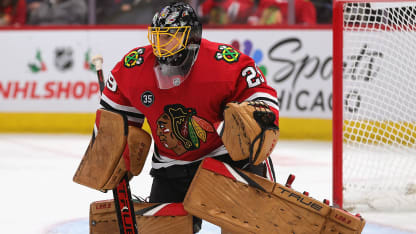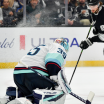Though each achievement qualifies Fleury for the honor, what happened between the two, during a miserable slump to start this season as the Chicago Blackhawks new No. 1 goalie, put his candidacy over the top for an award that has strived to look beyond the statistical surface since first being handed out four years ago.
Fleury, who was traded to the Blackhawks on July 27, less than one month after winning the Vezina Trophy with the Vegas Golden Knights, made a subtle change to his technique after starting the season 1-7-0 with a 4.11 goals-against average and .881 save percentage.
"Playing overlap on the post when guys are coming at an angle instead of sometimes playing one-knee down or stand-up or reverse-VH," Fleury explained of the change. "It's not something I've done before or worked on before."
In simple terms, the overlap technique is a butterfly save execution on plays from sharp angles, typically below the bottom of the face-off circle. The name comes from the short-side skate that is placed outside of that post rather than up against it, usually slightly below the goal line depending how low the attack gets.
If a goalie were to drop into a butterfly with their skate against the post, the very nature of that drop pushes them away from that short-side post because the skates flare out in the butterfly, leaving a gap between the arm and post. By positioning the skate outside the post, Fleury can keep his torso lined up with that post even if he drops into a wide-flare butterfly. At the same time, he can keep that short-side skate free from any interference with the post, which makes it a lot easier to move it to grab an edge to push into the middle in case there's a pass from that angled attack, or push across if it becomes a wraparound.
"I feel like I was getting caught on the post," Fleury explained. "When you go outside the post, you can go down and you still can push across."
Fleury had used a variety of sharp-angle techniques before, including the popular reverse-VH, in which a goalie drops the lead pad to the ice and anchors the back skate just above the goal line to drive their body into a post seal. He also used traditional VH, or one-pad down, which places the lead pad vertically up against the post with the back pad on the ice along the goal line.
"And sometimes I'd just stand up," Fleury said.
There are strengths and weaknesses to each option.
Fleury said he felt the reverse-VH left too big a hole over his short-side shoulder when he dropped into the post using that technique. And he said he didn't like the hole between his blocker and his body when he used traditional VH, or one-pad down on his glove side post. For a lot of goalies, the downside of using an overlap is it places more of their frame -- and therefore net coverage -- outside the post if the puck is passed into the middle, requiring a butterfly push to regain that coverage.
That's not a problem for Fleury, who remains among the NHL's quickest lateral goalies at age 37.
"It's good because sometimes you are in between with other ways," Fleury said.


















